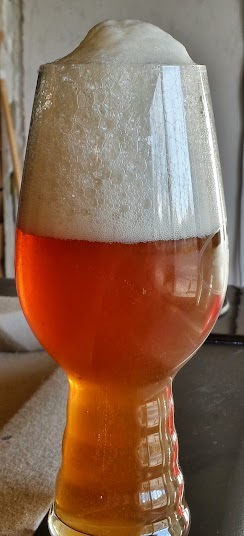Osedax
Well-Known Member
Recently I won a local homebrew competition with this IPA. Yes, entered against barley based beers. This recipe won its category and took best in show. I was pretty stoked on the win. I have the "award" glasses somewhere... Anyway, just thought I would share. Let me know what you guys think. The hop schedule is pretty awesome. (shh.. its the one from Lagunitas Hop Stoopid)
BeerSmith 2 Recipe Printout - http://www.beersmith.com
Recipe: Non-Black IPA
Brewer: Osedax
Asst Brewer: Brandon Matrese And Andrew Kitch
Style: American IPA
TYPE: All Grain
Taste: (30.0)
Recipe Specifications
--------------------------
Boil Size: 7.00 gal
Post Boil Volume: 5.50 gal
Batch Size (fermenter): 5.00 gal
Bottling Volume: 4.75 gal
Estimated OG: 1.067 SG
Estimated Color: 20.6 SRM
Estimated IBU: 101.7 IBUs
Brewhouse Efficiency: 70.00 %
Est Mash Efficiency: 77.0 %
Boil Time: 90 Minutes
Ingredients:
------------
Amt Name Type # %/IBU
5 lbs Red Millet (3.0 SRM) Grain 1 27.8 %
5 lbs White Quinoa (3.0 SRM) Grain 2 27.8 %
3 lbs Corn, Flaked (1.3 SRM) Grain 3 16.7 %
2 lbs Buckwheat, Oven Roasted (40.0 SRM) Grain 4 11.1 %
1 lbs Amaranth (3.0 SRM) Grain 5 5.6 %
0.75 oz Chinook [12.10 %] - First Wort 90.0 min Hop 6 44.7 IBUs
2.00 oz Columbus (Tomahawk) [16.30 %] - Boil 12. Hop 7 38.9 IBUs
1.25 oz Chinook [12.10 %] - Boil 12.0 min Hop 8 18.1 IBUs
2.00 oz Simcoe [13.00 %] - Boil 0.0 min Hop 9 0.0 IBUs
1.0 pkg SafAle English Ale (DCL/Fermentis #S-04) Yeast 10 -
1 lbs Candi Sugar, Amber (75.0 SRM) Sugar 11 5.6 %
1 lbs Honey, Buckwheat (60.0 SRM) Sugar 12 5.6 %
2.00 oz Columbus (Tomahawk) [14.00 %] - Dry Hop Hop 13 0.0 IBUs
Mash Schedule: Single Infusion, Medium Body, Batch Sparge
Total Grain Weight: 18 lbs

Its clearer than it looks. And that is a dogfish head IPA glass.

BeerSmith 2 Recipe Printout - http://www.beersmith.com
Recipe: Non-Black IPA
Brewer: Osedax
Asst Brewer: Brandon Matrese And Andrew Kitch
Style: American IPA
TYPE: All Grain
Taste: (30.0)
Recipe Specifications
--------------------------
Boil Size: 7.00 gal
Post Boil Volume: 5.50 gal
Batch Size (fermenter): 5.00 gal
Bottling Volume: 4.75 gal
Estimated OG: 1.067 SG
Estimated Color: 20.6 SRM
Estimated IBU: 101.7 IBUs
Brewhouse Efficiency: 70.00 %
Est Mash Efficiency: 77.0 %
Boil Time: 90 Minutes
Ingredients:
------------
Amt Name Type # %/IBU
5 lbs Red Millet (3.0 SRM) Grain 1 27.8 %
5 lbs White Quinoa (3.0 SRM) Grain 2 27.8 %
3 lbs Corn, Flaked (1.3 SRM) Grain 3 16.7 %
2 lbs Buckwheat, Oven Roasted (40.0 SRM) Grain 4 11.1 %
1 lbs Amaranth (3.0 SRM) Grain 5 5.6 %
0.75 oz Chinook [12.10 %] - First Wort 90.0 min Hop 6 44.7 IBUs
2.00 oz Columbus (Tomahawk) [16.30 %] - Boil 12. Hop 7 38.9 IBUs
1.25 oz Chinook [12.10 %] - Boil 12.0 min Hop 8 18.1 IBUs
2.00 oz Simcoe [13.00 %] - Boil 0.0 min Hop 9 0.0 IBUs
1.0 pkg SafAle English Ale (DCL/Fermentis #S-04) Yeast 10 -
1 lbs Candi Sugar, Amber (75.0 SRM) Sugar 11 5.6 %
1 lbs Honey, Buckwheat (60.0 SRM) Sugar 12 5.6 %
2.00 oz Columbus (Tomahawk) [14.00 %] - Dry Hop Hop 13 0.0 IBUs
Mash Schedule: Single Infusion, Medium Body, Batch Sparge
Total Grain Weight: 18 lbs

Its clearer than it looks. And that is a dogfish head IPA glass.






















![Craft A Brew - Safale S-04 Dry Yeast - Fermentis - English Ale Dry Yeast - For English and American Ales and Hard Apple Ciders - Ingredients for Home Brewing - Beer Making Supplies - [1 Pack]](https://m.media-amazon.com/images/I/41fVGNh6JfL._SL500_.jpg)























 My notes are not as good as they normally are.
My notes are not as good as they normally are.
